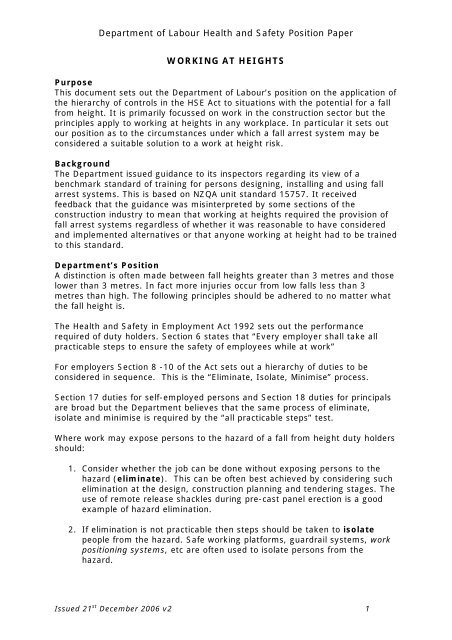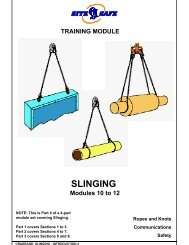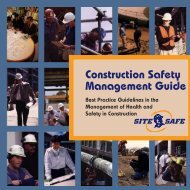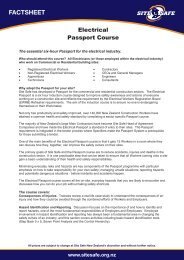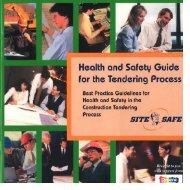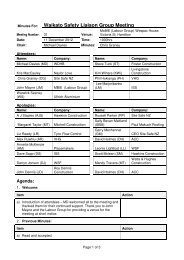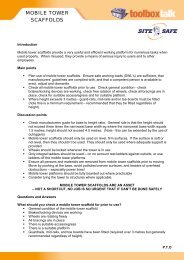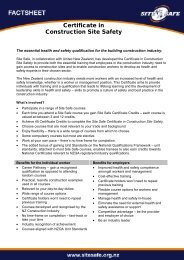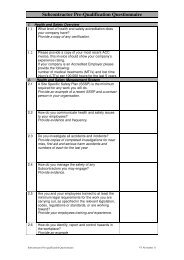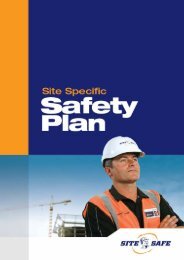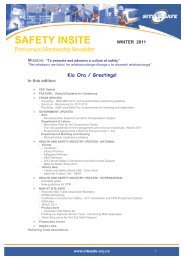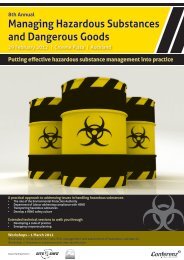Working at Heights Safety Position - Site Safe
Working at Heights Safety Position - Site Safe
Working at Heights Safety Position - Site Safe
Create successful ePaper yourself
Turn your PDF publications into a flip-book with our unique Google optimized e-Paper software.
Department of Labour Health and <strong><strong>Safe</strong>ty</strong> <strong>Position</strong> Paper<br />
WORKING AT HEIGHTS<br />
Purpose<br />
This document sets out the Department of Labour’s position on the applic<strong>at</strong>ion of<br />
the hierarchy of controls in the HSE Act to situ<strong>at</strong>ions with the potential for a fall<br />
from height. It is primarily focussed on work in the construction sector but the<br />
principles apply to working <strong>at</strong> heights in any workplace. In particular it sets out<br />
our position as to the circumstances under which a fall arrest system may be<br />
considered a suitable solution to a work <strong>at</strong> height risk.<br />
Background<br />
The Department issued guidance to its inspectors regarding its view of a<br />
benchmark standard of training for persons designing, installing and using fall<br />
arrest systems. This is based on NZQA unit standard 15757. It received<br />
feedback th<strong>at</strong> the guidance was misinterpreted by some sections of the<br />
construction industry to mean th<strong>at</strong> working <strong>at</strong> heights required the provision of<br />
fall arrest systems regardless of whether it was reasonable to have considered<br />
and implemented altern<strong>at</strong>ives or th<strong>at</strong> anyone working <strong>at</strong> height had to be trained<br />
to this standard.<br />
Department’s <strong>Position</strong><br />
A distinction is often made between fall heights gre<strong>at</strong>er than 3 metres and those<br />
lower than 3 metres. In fact more injuries occur from low falls less than 3<br />
metres than high. The following principles should be adhered to no m<strong>at</strong>ter wh<strong>at</strong><br />
the fall height is.<br />
The Health and <strong><strong>Safe</strong>ty</strong> in Employment Act 1992 sets out the performance<br />
required of duty holders. Section 6 st<strong>at</strong>es th<strong>at</strong> “Every employer shall take all<br />
practicable steps to ensure the safety of employees while <strong>at</strong> work”<br />
For employers Section 8 -10 of the Act sets out a hierarchy of duties to be<br />
considered in sequence. This is the “Elimin<strong>at</strong>e, Isol<strong>at</strong>e, Minimise” process.<br />
Section 17 duties for self-employed persons and Section 18 duties for principals<br />
are broad but the Department believes th<strong>at</strong> the same process of elimin<strong>at</strong>e,<br />
isol<strong>at</strong>e and minimise is required by the “all practicable steps” test.<br />
Where work may expose persons to the hazard of a fall from height duty holders<br />
should:<br />
1. Consider whether the job can be done without exposing persons to the<br />
hazard (elimin<strong>at</strong>e). This can be often best achieved by considering such<br />
elimin<strong>at</strong>ion <strong>at</strong> the design, construction planning and tendering stages. The<br />
use of remote release shackles during pre-cast panel erection is a good<br />
example of hazard elimin<strong>at</strong>ion.<br />
2. If elimin<strong>at</strong>ion is not practicable then steps should be taken to isol<strong>at</strong>e<br />
people from the hazard. <strong>Safe</strong> working pl<strong>at</strong>forms, guardrail systems, work<br />
positioning systems, etc are often used to isol<strong>at</strong>e persons from the<br />
hazard.<br />
Issued 21 st December 2006 v2 1
Department of Labour Health and <strong><strong>Safe</strong>ty</strong> <strong>Position</strong> Paper<br />
3. If neither 1 nor 2 are practicable then steps should be taken to minimise<br />
the likelihood of harm resulting. This means considering the use personal<br />
protective equipment, safety nets, airbags, fall arrest systems, etc.<br />
The Department of Labour will never recommend minimis<strong>at</strong>ion as the first<br />
option. Many organis<strong>at</strong>ions have shown th<strong>at</strong> with adequ<strong>at</strong>e planning, cooper<strong>at</strong>ion<br />
between parties and effective design it is possible to elimin<strong>at</strong>e or<br />
significantly reduce working <strong>at</strong> height in the first place.<br />
At each decision point the test to be applied is practicability not just cost.<br />
Regul<strong>at</strong>ion 21 of the Health and <strong><strong>Safe</strong>ty</strong> in Employment Act Regul<strong>at</strong>ions<br />
1995<br />
This Regul<strong>at</strong>ion is the source of the often-quoted “3 metre rule”. It is often<br />
mistakenly believed th<strong>at</strong> no further action is needed where a person faces a fall<br />
of less than 3 metres. Th<strong>at</strong> belief is wrong and ignores the over-arching duties in<br />
the Act set out above.<br />
The Regul<strong>at</strong>ion means th<strong>at</strong> if a person is exposed to a fall of gre<strong>at</strong>er than 3<br />
metres a system has to be put in place to prevent a person falling.<br />
Falls from less than three metres often result in serious harm. The HSE<br />
Act requires th<strong>at</strong> ‘all practicable steps’ be taken to prevent such harm.<br />
In essence, Regul<strong>at</strong>ion 21 merely reinforces the requirement for a<br />
means of preventing a fall <strong>at</strong> height gre<strong>at</strong>er than three metres.<br />
Fall Arrest Systems<br />
Fall arrest systems should only be considered when all other safer options have<br />
been excluded. Considerable care and <strong>at</strong>tention is required for fall arrest<br />
systems to be effective. They are not a cheap or easy option. Fall arrest does<br />
not protect persons from falling; r<strong>at</strong>her it stops them hitting the ground. Injury<br />
may still result and there are potentially f<strong>at</strong>al risks arising from suspension<br />
trauma if someone suspended in a harness after a fall is not rescued promptly.<br />
A minimum clear distance of <strong>at</strong> least 6.55 metres is usually required below the<br />
anchor point for a fall arrest system to properly deploy (this when the anchor<br />
point is above the person).<br />
Specialised skills are required to plan, install and oper<strong>at</strong>e a fall arrest system<br />
correctly. As such those involved need specialised training and experience The<br />
Department’s position is th<strong>at</strong> NZQA 15757 or equivalent or better is the<br />
benchmark against which to assess the knowledge requirements. Other types of<br />
“work <strong>at</strong> height” training will enable informed decisions to be made around the<br />
hierarchy of control measures set out above, but are unlikely to go into sufficient<br />
detail in rel<strong>at</strong>ion to the specific issues surrounding fall arrest systems.<br />
Inform<strong>at</strong>ion<br />
Further inform<strong>at</strong>ion of on how to prevent falls from height can be obtained from<br />
the Department of Labour <strong>at</strong> www.dol.govt.nz and <strong>Site</strong><strong>Safe</strong> <strong>at</strong><br />
www.sitesafe.co.nz.<br />
Issued 21 st December 2006 v2 2


